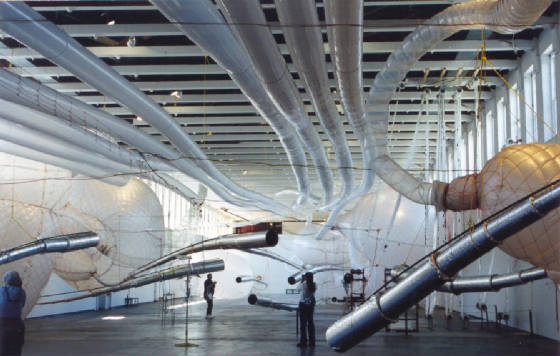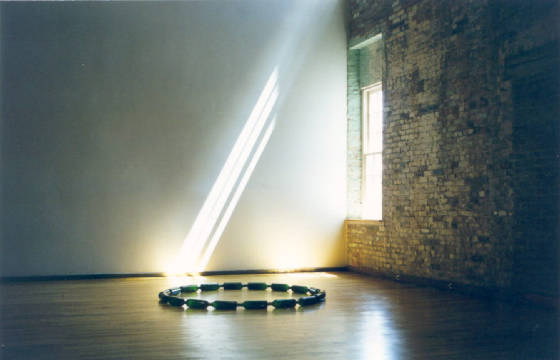|
|
Jim Daunais was born in Adams 58 years ago, and has lived there most of his life. For a time, his mother worked in the Berkshire Mills. He remembers the noise she had to put up with.
“One time, my sister and I went to pick her up, and I was parked near the door. The noise was so horrendous in the mill that I could barely hear my sister talking in the car. I can just imagine what the sound must have been like inside. That’s why all the workers stuffed cotton in their ears.”
Later, his mother rolled capacitors at Sprague Electric. Ironically, her son is now a security guard for Sprague’s cultural descendant, the Massachusetts Museum of Contemporary Art. Daunais says the mill is a bit quieter now, especially during the off-season. But he is not daunted by the vast gallery spaces he roams hour by hour on long, gray winter days. Instead, he is consumed by them.
“I’ve been interested in the outdoor world all my life, and that has made me very observant. After spending lots of time in the galleries, some of the guards will complain, ‘I don’t want to be in that room again. I was just there. I’ve seen it already.’ Sometimes I’ll just cryptically say, ‘You haven’t seen it already.’ They look at things, but they don’t see them.”
So what does he see on his daily journeys through the museum?
“On some of the old floorboards that were put back down again, you see a lot of marks and chips and gouges, or the side of a bolt impressed in the floor. One of the floorboards in Building 4 has a little half-moon shape burned into it. It might have been caused by a half-moon-shaped foot on the base of a leg of a machine table that vibrated over the years.”
“Some of the grain patterns seem to be matched from one end of a board to another, or from one side of a board to another. That would be pretty hard to do deliberately, because those floorboards are at random lengths. When I asked the fellow who did the floors about it, he said, ‘You know, it’s really weird, because we couldn’t see the grain when we put them down. They were black with years of varnish and dirt.’”
Daunais isn’t just observant with his eyes. He hears and feels the buildings as well.
“There are creaks and shifts in the winter when the wind is hitting it. In the summer, when the buildings heat up, they make little noises. On the second floor of Building 4, you can feel people walking on the third floor sometimes. The vibrations travel right down through. These buildings were built with stick walls and stick floors and beams and timbers. People say that they were built like the Rock of Gibralter, but there’s still a lot of resonance in them.”
As a kid, Daunais wanted to be a farmer when he grew up, because he loved working outdoors. But since high school, he’s had a variety of jobs: landscaper, carpenter’s helper, mason’s tender, factory production worker, and salesman. He was working at Guido’s Market when he and his wife learned through a friend about the Mass MoCA job.
“I went in for the interview, and they told me how they wanted the security people to know something about the art and be able to answer questions and talk a little about the art with the patrons. I had some interest in art – I once worked at the Norman Rockwell Museum for six months – but I didn’t know if I could relate to contemporary art. We really hadn’t been exposed to it in North County.”
But he signed on, only two weeks before the museum opened. Given the vastness and idiosyncrasies of the buildings, he had a lot to learn about the security end of the job in a short time. He also needed a crash course in the art. Curator Laura Heon gave all the employees a thorough tour. Daunais listened closely and found the art very interesting. He apparently did his homework.
As a longtime museum member, this writer and photographer has explored the galleries many times, and I have learned that the fellow with “Jim – Security” on his shirt is a dependable resource when I want to find the best spot to take a picture. He always seems to know what time of day the sun will peek through a particular window, or where and when a curious shadow or reflection will appear on a floor or wall. And when I want to know more about a new installation, he finds the right words to explain it.
“Sometimes people tell me that they like what I told them about the art better than what the tour guide said. Maybe that’s because I reflect both an informed and an everyday common man’s view. A lot of the tour guides are art history students. Many times, I’ve run into people here who know the artists personally or have a lot of knowledge about them, so I’ve had the opportunity to learn what an artist’s thought processes were.”
“You can appreciate the art a lot more when you know what the artist was thinking. For instance, The Gleaners (an 1857 painting by Jean Francois Millet) shows some people working in the fields. Rather than just saying, ‘Oh, it has pretty colors,’ you can enjoy it more if you understand that the artist was trying to humanize these common workers, so people of the era could relate to the way they had to live.”
Daunais enjoys talking to all types of visitors, especially former Sprague employees.
“When they walk in, they’re amazed. They try to find the places they were so familiar with. They notice a floor or a doorway that wasn’t there before, and I tell them that it might have been covered up with bricks or sheet rock when they worked here. A lot of them say they enjoy the buildings as much as the art.”
Among his favorite artworks at the museum has been Michael Oatman’s Long Shadows, an installation about Henry Perkins and the Eugenics Survey in Vermont. It was shown during the Unnatural Science exhibit several years ago. The eugenics movement of the early 20th century espoused the scary idea of human population improvement through selective breeding. Visitors entering the exhibit saw wall charts, books, a desk, and an old typewriter, in a room designed to look like a study. Daunais was often amused by the reaction of visitors.
“I’d get a kick out of people walking in and commenting, ‘Hey, I thought we were going to see contemporary art, but it looks like we’re going to do some antiquing today.’ I loved it when they finally worked their way through the room and came out with a very serious expression on their faces.”
And there’s the famous Uberorgan, by Tim Hawkinson, which filled up the large gallery in Building 5, now occupied by Robert Wilson’s 14 Stations.
“I watched him putting the horns together. He created most of it right there on the floor. He had those plastic bags all over the place. When he saw the gallery space, he envisioned the white-painted beams on the ceiling as a gigantic rib cage of some living creature. Then he imagined all the internal organs functioning around it, and also playing music. He made a small side reference to Herman Melville, who wrote Moby Dick while he lived in the Berkshires. Walking into the gallery, I felt like Jonah entering the body of a whale. Sometimes, I thought it sounded like two whales calling back to one another. Some visitors told me it reminded them of the closing sequence of Close Encounters of the Third Kind.”
Uberorgan proved to be a frightening obstacle for some of the museum’s younger visitors. “One guy was carrying a little boy, and when he opened the door, the kid screamed. No matter how much he tried, he couldn’t get that child into the room.” Another boy’s encounter with the alien musical instrument grew into a heartwarming story that even artist Hawkinson could not have envisioned.
“The boy was autistic. His mom would bring him in, and at first she couldn’t get him very far into the room. Eventually, they could go through the whole room, although at times he would hold his hands over his ears. Finally, he conquered it. It became his piece, and he loved it.”
“He had been participating in a therapeutic horseback-riding program. Richard Criddle (director of fabrication and installation at Mass MoCA) and his wife were volunteering at this program. Richard and the boy got to know each other, and Richard learned about the boy’s attachment to Uberorgan. So when it was about to be taken down, Richard invited him to come in and assist in lowering a couple of installations from the ceiling. That helped the boy adjust to the fact that it was going away for good.”
Perhaps it is fitting that his father once met painter Grandma Moses.
“When my dad was working in the color shop at Arnold Print Works in Adams, he worked elbow to elbow with Grandma Moses getting the colors mixed for her paintings that she was putting on fabric. He said she was the sweetest old woman you would ever want to meet. A while ago, there was a woman visiting the museum who happened to tell me that she remembers when her dad brought her to the old Arnold Print Works here in North Adams. Her father turned out to be the owner of the former Riverdale Fabrics, and he was the one who convinced Grandma Moses to put her art on fabric.”
Daunais says Mass MoCA is more than just a place to work. He and his wife often come to events in the evening.
“Working at the museum has changed my life in many ways. I’ve learned to make greater use of my senses in day-to-day life. There are so many things that you think you’ve seen, but you haven’t really seen them. It’s not only changed me; it’s changed North Adams. When I heard that the Fitzpatricks were investing in the River Street houses and creating The Porches Inn, I thought to myself, ‘If nowhere else, at least in their minds, something has turned the corner up here.’”
|
|

